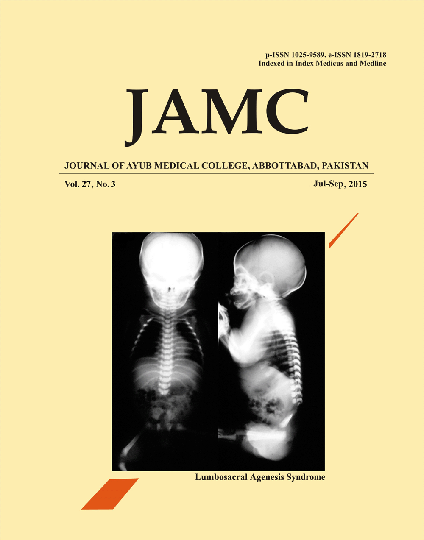DIAGNOSTIC IMPORTANCE OF BONE MARROW EXAMINATION IN HAEMATOLOGICAL MALIGNANT AND NON-MALIGNANT DISORDERS
Abstract
Background: Bone marrow examination is regarded as one of the most important diagnostic procedure to assess various haematological disorders. The uses and advantages of bone marrow aspiration are numerous. This study was conducted with the aim to evaluate the frequency of involvement of bone marrow with malignant and non-malignant haematological and other clinical disorders and to observe the significance of bone marrow in establishing primary diagnosis of the same condition. Methods: This was descriptive carried out at the Department of Pathology, Women Medical College, Abbottabad. A total of 570 successful bone marrow examinations were performed. Patients of all age groups and genders were included in the study. After history, clinical examination and blood complete counts, bone marrow was aspirated from posterior superior iliac spine, sternum or tibia. Smears were made, stained and examined under microscope. Results: Total numbers of cases were 570. Ages ranged from 6 months to 70 years. Male to female ratio was 2:1. The common clinical presentation for bone marrow examination were progressive pallor, fever of unknown origin and bleeding. Total numbers of non-malignant haematological conditions were 417 (73.2%) while the numbers of malignant conditions were 153 (27.8%). Conclusion: Bone marrow examination remains a simple, reliable and effective technique in the diagnosis of many important clinical conditions. It is a reliable accessible tool for diagnosing various haematological malignant and non-haematological conditions. The importance of bone marrow examination is further highlighted in cases where routine investigations fail to reach a conclusive diagnosis. Treatable conditions like visceral leishmaniasis and malaria are diagnosed and the result is decreased mortality from these diseases.References
Shaheen N, Khan MQA, Azim W, Ali N. Bone marrow aspiration. The diagnostic tool in haematological and non-haematological disorders. Pak J Pathol 2010;21(1):1-4
Gupta N, Kumar R, Khajuria A. Diagnostic assessment of bone marrow aspiration, smears, touch imprints and trephine biopsy in haematological disorders. JK Sci 2010;12(3):130–3.
Syed NN, Moiz B, Adil SN, Khurshid M. Diagnostic importance of bone marrow examination in non-haematological disorders J Pak Med Assoc 2007;57:123–5.
Weinzierl EP, Arber DA. Bone marrow evaluation in new onset pancytopenia. Hum Pathol 2013;44(6):1154–64.
Lewandowski K, Complak A, Hellmann A. Microscopic examination of bone marrow aspirates in malignant disorders of haematopoiesis-a comparison of two slide preparation technique. Ann Hematol 2012;91(4):497–505.
Hyun BH. Bone marrow examination: Adventures in Diagnostic Hematology. Yonsei Medi J 1986;27(2):100–5.
Shaheen N, Qaiser M. Bone marrow aspiration: The diagnostic tool in haematological and non-haematological disorders. Pak J Pathol 2010;21:1–4
Manan M, Khaliq MA, Ahmed S, Qayyum I and Idrees M. Diagnostic significance of BM examination. J Ayub Med Coll Abbottabad 2000;12:43–45
Afzal S, Ahmed A. Significance of bone marrow trephine biopsy in the diagnosis of haematological and non-haematological disorders. Pak J Pathol 2006;17(1):10–15
Bashawri LA. Bone marrow examination. Indications and diagnostic value. Saudi Med. J 2002;23(2):191–6.
Syed NN, Moiz B, Adil SN. Diagnostic importance of bone marrow examination in non-haematological disorders. J Pak Med Assoc 2007;57(3):123–5.
Tanoli ZM, RAI MH, Gandapur ASK: Clinical Presentation and management of visceral leishmaniasis. J Ayub Med Coll Abbottabad 2005;17(4):51–3.
Khan AS, Malik SA. Bone Marrow changes in falciparum malaria, J Pak Med Assoc 1997;47(5):137–9.
Published
Issue
Section
License
Journal of Ayub Medical College, Abbottabad is an OPEN ACCESS JOURNAL which means that all content is FREELY available without charge to all users whether registered with the journal or not. The work published by J Ayub Med Coll Abbottabad is licensed and distributed under the creative commons License CC BY ND Attribution-NoDerivs. Material printed in this journal is OPEN to access, and are FREE for use in academic and research work with proper citation. J Ayub Med Coll Abbottabad accepts only original material for publication with the understanding that except for abstracts, no part of the data has been published or will be submitted for publication elsewhere before appearing in J Ayub Med Coll Abbottabad. The Editorial Board of J Ayub Med Coll Abbottabad makes every effort to ensure the accuracy and authenticity of material printed in J Ayub Med Coll Abbottabad. However, conclusions and statements expressed are views of the authors and do not reflect the opinion/policy of J Ayub Med Coll Abbottabad or the Editorial Board.
USERS are allowed to read, download, copy, distribute, print, search, or link to the full texts of the articles, or use them for any other lawful purpose, without asking prior permission from the publisher or the author. This is in accordance with the BOAI definition of open access.
AUTHORS retain the rights of free downloading/unlimited e-print of full text and sharing/disseminating the article without any restriction, by any means including twitter, scholarly collaboration networks such as ResearchGate, Academia.eu, and social media sites such as Twitter, LinkedIn, Google Scholar and any other professional or academic networking site.









